No. 842 - Lindisfarne - St Aidan's Anglican Church - "A Gradual Undertaking"
Lindisfarne is an eastern shore suburb within the Greater Hobart area. It is named after "Lindisfarne House", a property situated in the adjoining suburb of Rosny. The area was originally known as Beltana but this was changed to Lindisfarne in 1903.
In the early 1890s Anglican services at Lindisfarne were held in a “recreation pavilion” and later in the local State school. Fundraising for building a place of worship began in the late 1890s with the aim of establishing a Mission Hall which could also be be used for social gatherings. [see No. 727] By 1907 sufficient funds had been raised for the project to proceed and a Mission Hall was completed by the end of that year. However, by the 1920s Lindisfarne’s population had grown considerably, which led to the Mission Hall’s replacement with St Aidan’s church in 1926.
Due to high building costs it was intended that the new church would be built in stages as a “gradual undertaking”. However, while the church was extended in 1962, it never realised the vision of its architect, Alexander North, whose design included a “rearing tower”.
The ceremonial foundation-stone lying ceremony for St Aidan’s took place on Saturday 25 April 1925. The Hobart Mercury’s report on the occasion is somewhat effusive:
“Upon a knoll looking down from some small eminence upon tie lower portion of picturesque Lindisfarne, and the blue water beyond, a considerable group of residents of the township stood on Saturday, in the golden, glow of a sunny afternoon, by the recently laid foundation of what, if the pious aspirations of those who have set themselves about to compass its realisation are rewarded, will be a fine and even stately Anglican church, in full view upon the Derwent of ships that come and ships that go. But the day of that realisation will not be yet, nor for very long, indeed. The people are content, however, to proceed step by step, and modestly, with the scheme. This provides for the present construction of the chancel and sanctuary, with annexe, which will give sufficient accommodation for existing requirements. Later, probably very much later, a fairly large parish church, will come bit by bit as funds permit and the need arises, with nave, transepts, organ chamber, and vestries, and rearing tower where nave and transepts cross”.
“The foundations providing for the chancel sanctuary, and annexe instant prospect are already laid on cement concrete, and the walls are to be of brick with dressed stone. The chancel will have a handsome open, roof, with tile covering and oak roof principals open to the interior. The floor of the sanctuary will be of tiles and the east wall behind the altar of dressed and carved stone. The work in immediate contemplation will probably cost £2000….”.
“The foundation-stone was laid by the Bishop of Tasmania (the Right Rev. Dr. Hay), ….The usual short service preceded the actual laying of the stone…..The church has been designed by Mr Alex North, architect, of Launceston, and its construction is being supervised by Messrs Roy Smith and Frank Heyward, architects, of Hobart. The work so far completed has been carried out by Mr Alfred Cranston, contractor, of Lindisfarne…”.
The church was completed in a little under a year and was dedicated on Sunday 7 March 1926. The Mercury reported:
“The seventh century in England saw the foundation of the Northumbrian Church, Saint Aidan being sent from Iona in 635 to become the Bishop of Northumbria. He established himself in the Monastery of Lindisfarne, where he achieved a great work. Appropriately enough, the new Anglican church in the Hobart suburb of Lindisfarne,…has chosen St. Aidan as its patron saint”.
“The people have made a modest beginning, the church at present being able to seat about 150, but ample provision has been made for additions when they are rendered necessary by the growth of the suburb, and when funds permit. Members of the congregation and other friends have made valuable gifts to the church, the altar and its accessories, sanctuary chair, credence table, alms-dish, altar rails, font (which is of stone) and ewer, and matting having been given. Standing on a foundation of dressed stone, the church is an imposing brick structure, with portion of the walls made of asbestos, artistically adorned with Tasmanian oak. The woodwork of the interior is composed principally of Tasmanian oak, the exception being the altar rails, which are of myrtle inlaid with other Tasmanian woods. The making of the altar rails, altar, and sanctuary chair, was carried out by Mr. F. Bartlett, of Lindisfarne. The cost, up to date, is about £1,420, but to complete the building according to the architect's plan will require about £3,000”.
“At the dedication service, which was conducted by the Bishop (Dr. R. S. Hay) yesterday morning, there was a crowded congregation. The churchwardens, Col. D. A. Lane, Messrs. W. Stone and B. Phelan having presented the petition signed by the Rector (the Rev. H. C. Brammall) and themselves, the Bishop proceeded with the dedication service….”.
The original Mission Hall still stands beside St Aidan’s although it has been moved and extensively renovated. In the 1920s a proposal was made to sell the building for use as a public hall but this never eventuated.
The cost of realising Alexander North’s plan for a substantial church proved prohibitive, and while the building has been extended, his vision has not been realised. While there is no “rearing tower” the church is an attractive building which has served the Anglican community for nearly a century.
In the early 1890s Anglican services at Lindisfarne were held in a “recreation pavilion” and later in the local State school. Fundraising for building a place of worship began in the late 1890s with the aim of establishing a Mission Hall which could also be be used for social gatherings. [see No. 727] By 1907 sufficient funds had been raised for the project to proceed and a Mission Hall was completed by the end of that year. However, by the 1920s Lindisfarne’s population had grown considerably, which led to the Mission Hall’s replacement with St Aidan’s church in 1926.
Due to high building costs it was intended that the new church would be built in stages as a “gradual undertaking”. However, while the church was extended in 1962, it never realised the vision of its architect, Alexander North, whose design included a “rearing tower”.
The ceremonial foundation-stone lying ceremony for St Aidan’s took place on Saturday 25 April 1925. The Hobart Mercury’s report on the occasion is somewhat effusive:
“Upon a knoll looking down from some small eminence upon tie lower portion of picturesque Lindisfarne, and the blue water beyond, a considerable group of residents of the township stood on Saturday, in the golden, glow of a sunny afternoon, by the recently laid foundation of what, if the pious aspirations of those who have set themselves about to compass its realisation are rewarded, will be a fine and even stately Anglican church, in full view upon the Derwent of ships that come and ships that go. But the day of that realisation will not be yet, nor for very long, indeed. The people are content, however, to proceed step by step, and modestly, with the scheme. This provides for the present construction of the chancel and sanctuary, with annexe, which will give sufficient accommodation for existing requirements. Later, probably very much later, a fairly large parish church, will come bit by bit as funds permit and the need arises, with nave, transepts, organ chamber, and vestries, and rearing tower where nave and transepts cross”.
“The foundations providing for the chancel sanctuary, and annexe instant prospect are already laid on cement concrete, and the walls are to be of brick with dressed stone. The chancel will have a handsome open, roof, with tile covering and oak roof principals open to the interior. The floor of the sanctuary will be of tiles and the east wall behind the altar of dressed and carved stone. The work in immediate contemplation will probably cost £2000….”.
“The foundation-stone was laid by the Bishop of Tasmania (the Right Rev. Dr. Hay), ….The usual short service preceded the actual laying of the stone…..The church has been designed by Mr Alex North, architect, of Launceston, and its construction is being supervised by Messrs Roy Smith and Frank Heyward, architects, of Hobart. The work so far completed has been carried out by Mr Alfred Cranston, contractor, of Lindisfarne…”.
The church was completed in a little under a year and was dedicated on Sunday 7 March 1926. The Mercury reported:
“The seventh century in England saw the foundation of the Northumbrian Church, Saint Aidan being sent from Iona in 635 to become the Bishop of Northumbria. He established himself in the Monastery of Lindisfarne, where he achieved a great work. Appropriately enough, the new Anglican church in the Hobart suburb of Lindisfarne,…has chosen St. Aidan as its patron saint”.
“The people have made a modest beginning, the church at present being able to seat about 150, but ample provision has been made for additions when they are rendered necessary by the growth of the suburb, and when funds permit. Members of the congregation and other friends have made valuable gifts to the church, the altar and its accessories, sanctuary chair, credence table, alms-dish, altar rails, font (which is of stone) and ewer, and matting having been given. Standing on a foundation of dressed stone, the church is an imposing brick structure, with portion of the walls made of asbestos, artistically adorned with Tasmanian oak. The woodwork of the interior is composed principally of Tasmanian oak, the exception being the altar rails, which are of myrtle inlaid with other Tasmanian woods. The making of the altar rails, altar, and sanctuary chair, was carried out by Mr. F. Bartlett, of Lindisfarne. The cost, up to date, is about £1,420, but to complete the building according to the architect's plan will require about £3,000”.
“At the dedication service, which was conducted by the Bishop (Dr. R. S. Hay) yesterday morning, there was a crowded congregation. The churchwardens, Col. D. A. Lane, Messrs. W. Stone and B. Phelan having presented the petition signed by the Rector (the Rev. H. C. Brammall) and themselves, the Bishop proceeded with the dedication service….”.
The original Mission Hall still stands beside St Aidan’s although it has been moved and extensively renovated. In the 1920s a proposal was made to sell the building for use as a public hall but this never eventuated.
The cost of realising Alexander North’s plan for a substantial church proved prohibitive, and while the building has been extended, his vision has not been realised. While there is no “rearing tower” the church is an attractive building which has served the Anglican community for nearly a century.
St Aidan's before the 1962 extension (c.1959) - Photo credit: Photographer - Len Carter - supplied by
Gillian Baker (copyright) - please seek permission for use.
The old Mission Hall was moved from a site at what is now 180 East Derwent Highway.
The old Mission Hall was moved from a site at what is now 180 East Derwent Highway.
Photo Credit: The Mercury, March 1953
Sources:
Mercury, Thursday 15 April 1920, page 4
Mercury, Monday 27 April 1925, page 8
Mercury, Monday 8 March 1926, page 3
Mercury, Thursday 5 March 1953, page 6
Henslowe, Dorothea I & Hurburgh, Isa Our heritage of Anglican churches in Tasmania. Mercury-Walch, Moonah, Tas, 1978.
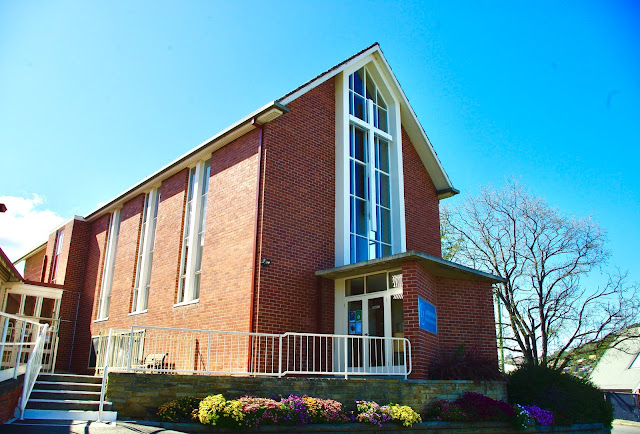
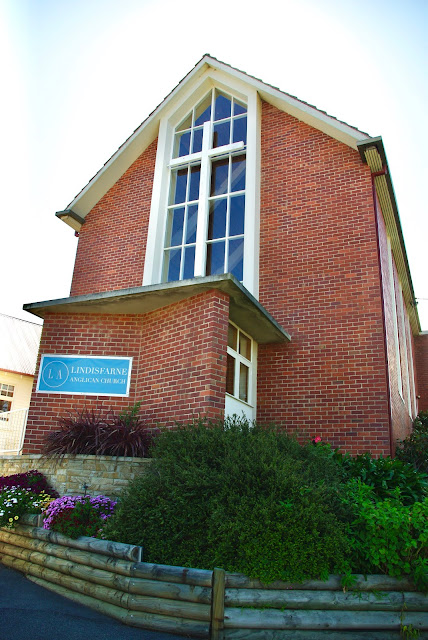
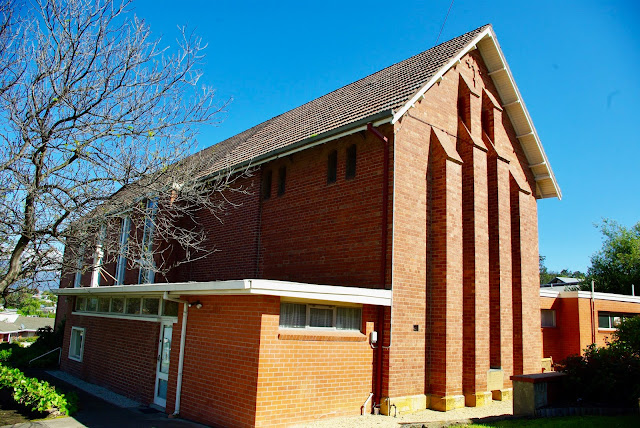

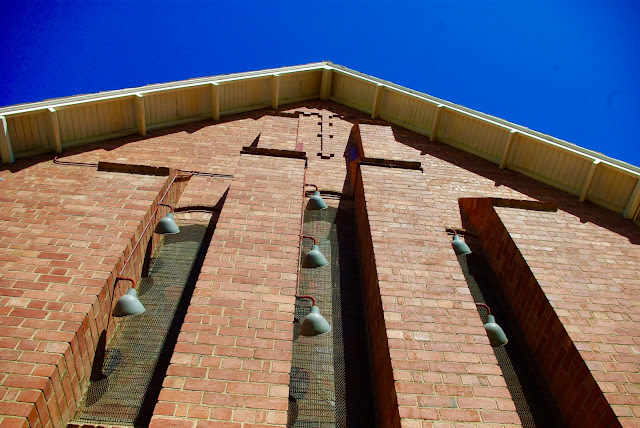

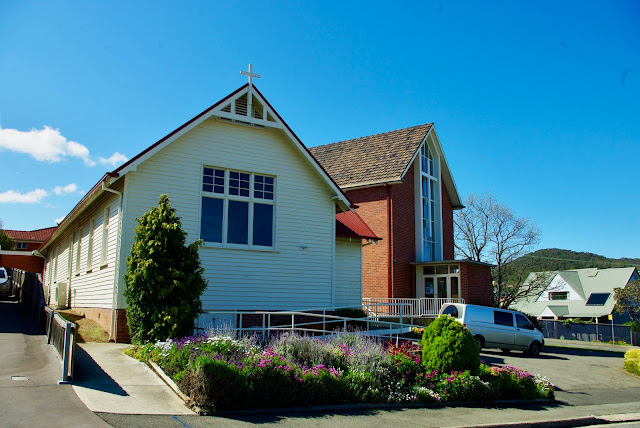






Comments
Post a Comment